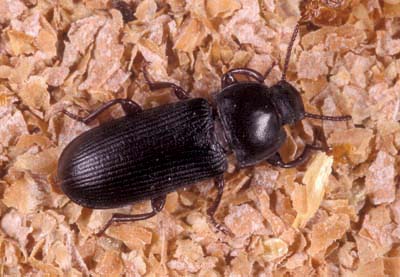
Adult yellow mealworm, Tenebrio molitor.
(Photographer: L.J. Buss, University of Florida)
The yellow mealworm generally feeds on milled grain with high moisture. It is worldwide in distribution. In the U.S., this species is more common in the cooler, northern states. Mealworms are only of moderate importance as stored product pests. They dwell in dark moist corners and hide under bags of feed in warehouses and feed stores, in grain bins or in the litter of chicken houses and birdhouses. The larvae wander about and are often found in unlikely places.
The adult yellow mealworm is shiny dark brown to black and reaches 13 mm in length. The antennae are not clubbed. The adults can fly and are often attracted to lights. The females lay an average of 400 to 500 eggs, singly or in clusters. This species gets its name from the yellowish appearance of the larvae. The life cycle can be completed in 10 months and there is one generation per year. Adults usually emerge in the spring or early summer and live for two or three months.
Images
To save the Web-optimized images shown below to your hard drive:
|
Click to access Display and Print quality images. |
|
Click to access Display and Print quality images. |
|
Click to access Display and Print quality images. |